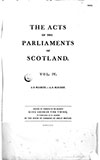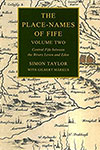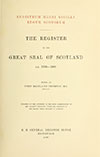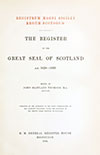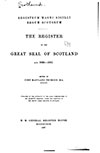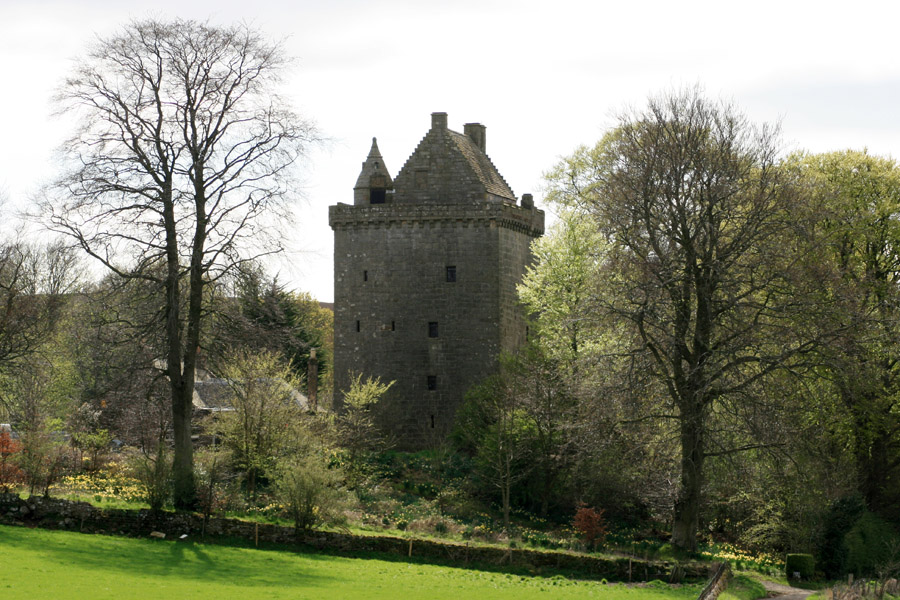

Scotstarvit Tower is a 17th century tower house which incorporates earlier work.
A castle here seems to have been built in the second half of the 15th century, and was certainly in existence by 1475, when it was known as Tarwald or Tarvet. It stands on a slight rocky outcrop, rising above the surrounding land.
The estate was acquired by the Inglis family in 1487 and in March 1488 Alexander Inglis of Tarwald resigned his lands of Tarwald and Caploquhy, superior and inferior, with their mills, and the half lands of Balbirny, which were then incorporated for him into the free barony of Tarwald.
Alexander Inglis was dead by 1518 and was succeeded by his son, also Alexander, who was married to Margaret Barclay, a daughter of Barclay of Innergellie. In February 1541 the younger Alexander resigned his lands of Tervait which were then erected into the free barony of Tarvait by James V for Alexander’s good service.
Alexander died at the Battle of Pinkie in 1547 and the following year his heir, also Alexander, was granted the barony and lands of Tarvet, the lands of Caiplie, Ovirtoun, Thrid part, the lands of Nethertoun de Caiplie with the mill, the half lands of Balbirny and fisheries, the dominical lands of Tarvett with Outsattis annexed to the barony of Tarvett, and the lands of Eister Pitcorthie. The younger Alexander was probably responsible for remodelling the tower between 1550 and 1579.
Alexander later resigned the lands and barony of Tarvat and they were granted to his son and heir apparent, John Inglis, by James VI in December 1579. John was married to Elizabeth Carnegie, daughter of David Carnegie of Colluthie.
Alexander died around 1590 and in 1604 John sold the lands and barony of Tarvet to his son, another Alexander. John was dead by 1610 and in October 1611 Alexander sold the lands of Caple-Ovirtoun Thridpairt, Nethertoun de Caple, with the mill, mill lands, etc., fisheries, fortalice and manor, and the lands of Eister Pitcorthie, with the consent of his wife, Martha Johnstoun, daughter of James Johnstoun of Elphingstoun, and his mother, Elizabeth Carnegie, to John Scot of Knychtspottie.
A month later Alexander sold the lands of Tarvett, with the fortalice, manor, rabbits, mill, mill lands, and fisheries, to the same John Scot, who renamed the property Scotstarvet after himself.
In February 1619 James VI granted to John Scott of Scottistarvet the “decimas garbales et vicarias decimas” lands of Over Caplie alias Thridpairt, the town and lands of Nethir Caplie with the mill and mill lands, and the town and lands of Eister Pitcorthie, which the Earl of Mar had resigned with the consent of William Barclay de Innergillie.
Sir John Scot was a Director of Chancery, member of the Privy Council and later a Lord of Session. In 1624 he received a charter of the two parts of the lands of Wester Pitcorthie, anciently owned by Dryburgh Abbey, from Sir William Anstruther of Anstruther. Perhaps as a result of his increasing status and fortunes, Sir John is said to have rebuilt the tower in 1627.
Scotstarvit Tower is a tall, simple tower, measuring around 10.1 metres by 8.2 metres, with a small wing measuring around 2.1 metres by 4.0 metres projecting to the south-east.
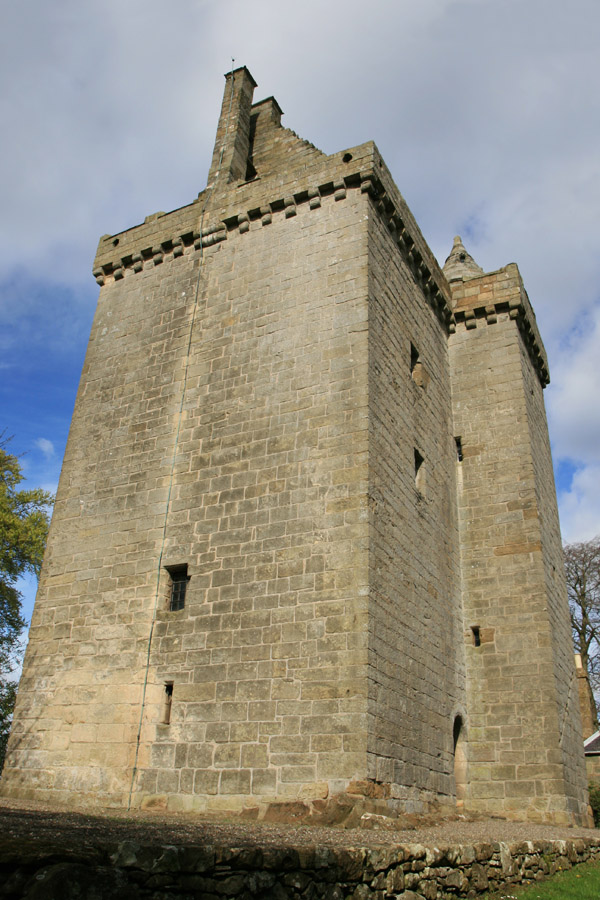
The entrance is at ground floor level, just to the west of the re-entrant angle. The door opens into a small hallway with access into the ground floor level ahead, and the spiral staircase leading up from the right.
The ground floor is a double height barrel-vaulted room, with corbels on the wall and twin windows one above the other indicating that it was originally split into two levels by a wooden floor.

The same arrangement continues higher up in the tower, the second and third floors being formed by the insertion of a wooden floor within a double height barrel-vaulted room.
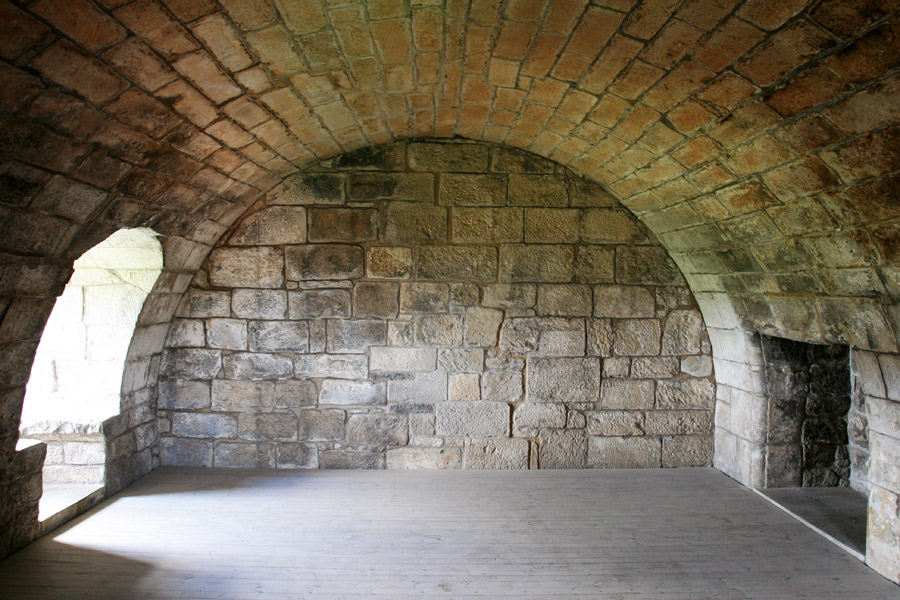
Above that is the fourth floor, at the bottom of another double-height space. Again corbels on the wall show that this space would have been divided, with a garret level under the roof making six floors in total.

An ornate carved stone fireplace once warmed the garret level, but it was removed to Hill of Tarvit mansion house in the early 20th century. It is carved with the date 1627, the initials JS and AD for John Scot and his wife Anne Drummond, sister of Sir William Drummond of Hawthornden, and the arms of both families.
The spiral staircase continues up into a circular caphouse with conical roof. A door gives access to the parapet walk, and above the door is a carved armorial panel once again carrying the arms of John Scot and Anne Drummond and the date 1627.
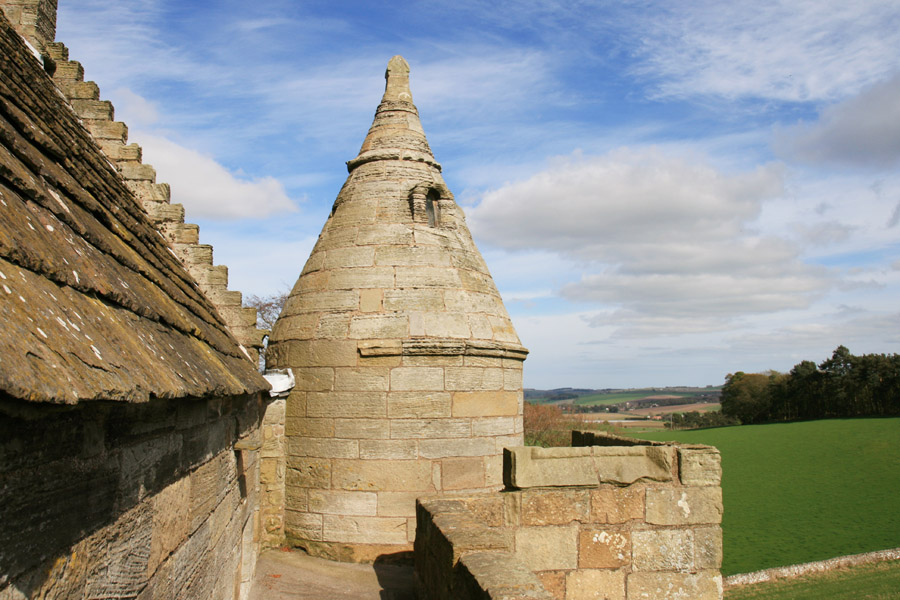

Evidently there were originally ancillary buildings around the base of the tower, and probably also a courtyard wall, but these have now been removed and their place taken by a 19th century cottage.
In July 1631 Charles I granted to John Scott of Scottistarvett the lands and barony of Scottistarvett comprising of the lands and barony of Tarvett, the lands and barony of Caiplie annexed to the barony of Tarvett, the lands of Eister Pitcorthie in the parish of Kilrynnie, and various others, which were incorporated into the free barony of Scottistarvett.
As part of the agreement Scott was due to pay the minister of the church of Kilrynnie £75 (and therefore the 600 merks which were due to be paid by the heir of William Barclay of Innergellie).
In July 1635 Charles I granted the lands and barony of Tarvett to James Scott, legitimate son of Lord John Scott of Scottistarvett, and Marjorie Carnegie, his spouse, and their male heirs. This included the tower, manor, rabbits and mill, the lands and barony of Caiplie, comprising the lands of Caiplie-Ovirtoun known as Thridpairt with the pendicle of Scabert, the lands of Nathertoun de Caiplie with the mill, fisheries, tower and manor annexed to the barony of Tarvett, the lands of Eister Pitcorthie (once held by the abbey of Hadingtoun), the privileges of the communal pasture of Kingismure and Craillmure, and the lands of Wester Pitcorthie, all of which John resigned and all of which were erected into the free barony of Scottistarvett with the manor of Tarvet as its principal messuage.
Scotstarvit Tower remained in the Scot family until 1776, when, upon the death of John Scot’s great-great-grandson Major-General John Scot, a Member of Parliament for Fife, the male line failed. Scotstarvit passed to this John Scot’s eldest daughter, but she sold the estate to Oliver Gourlay of Craigrothie who then sold it soon after to Colonel Wemyss of Wemysshall (now Hill of Tarvit).
In 1903 the Wemyss family sold Scotstarvit Tower and Hill of Tarvit to a Dundee jute magnate by the name of Frederick Bower Sharp, better known as F.B. Sharp. His daughter left the properties to the National Trust for Scotland in 1948 following her death. Scotstarvit Tower continues to be owned by the National Trust for Scotland but is managed by Historic Scotland.
Alternative names for Scotstarvit Tower
Inglis-Tarvatt; Inglis-Tarvet; Inglistarvit; Scotstarver; Scotstarvet; Scottistarvett; Tarvait; Tarvat; Tarvatt; Tarvet; Tarvett; Tarwald; Tarwet; Tervait; Terwald





